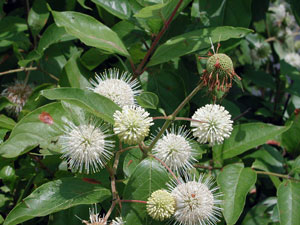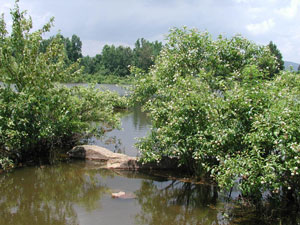Resource Library
Plant of the Week: Buttonbush
The University of Arkansas System Division of Agriculture does not promote, support or recommend plants featured in "Plant of the Week." Please consult your local Extension office for plants suitable for your region.
Plant of the Week
Buttonbush
Latin: Cephalanthus occidentalis

Native shrubs get only modest attention in our gardens, but governmental policies aimed at protecting water quality are shining a light on many once little-used natives. One of these is buttonbush, Cephalanthus occidentalis, a gangly deciduous shrub native in wet places over an extensive range from Maine to central Mexico, and even California.
Buttonbush is a 3 to 6 foot tall and wide shrub that can get twice as large in warm places. It is one of six species in the genus and is classified as a member of the coffee family. Cephalanthus occidentalis is the most widely distributed species, occurring throughout the eastern states and Canadian provinces, across the southwest and into California and widely in central Mexico, and even Cuba. At one time, the south Asian and Chinese species, which is very similar, was considered to be in the same species but is now given another name. Additional species are recognized in South America and South Africa.
Buttonbush is late to leaf out in the spring, but when it does it produces a crop of 4 to 6 inch-long elliptic leaves that are bright green and shiny. Leaves are arranged opposite or whorled on the stout branches, a characteristic shared by coffee.
The most ornamental feature of buttonbush is its round, creamy-white, ball-shaped inflorescence, which is about an inch in diameter and produced on a 2 inch-long nodding peduncle. Hundreds of tiny flowers make up the inflorescence, from which protrudes a single style from the center of each blossom. The overall effect is that of a table-tennis ball used as a pin cushion. Individual heads remain in bloom for about 2 weeks, but the plant continually produces new flowers from midsummer until early fall. The fruit is a brown, half-inch diameter, ball-shaped cluster of nutlets.

Buttonbush is a plant of streamsides and pond edges, sometimes even growing in shallow standing water. It is a favorite of conservationists wishing to stabilize riparian zones and prevent erosion. Its flowers are favorite nectar sources for butterflies in the summer, its foliage is routinely browsed by deer and its seeds are eaten by birds in the winter, making it an important component of the natural ecosystem.
The worldwide distribution of the six species recognized by botanists is interesting and can be explained as either an artifact of continental drift or as a result of long range dispersal, probably by migrating birds. For continental drift to be the explanation, then the genus would have to have originated about 250 million years ago, before the supercontinent Pangaea broke up, which is unlikely since most angiosperms did not begin appearing in the fossil record for about another 100 million years.
A more likely explanation is that a single species once occupied a continuous range from present day North America into present day Asia, perhaps as recently as 10 million years ago. The cooling climate and drifting continents separated the plants into two populations, which evolved their slightly different characteristics. Because buttonbush frequents wet places, it is not much of a leap of logic to suspect that migrating waterfowl may have moved the seeds to the Southern Hemisphere, where different climatic conditions shaped the new arrivals into different species.
Buttonbush is a coarse mound of brush in the winter months, so it is best used in wet areas and as a background plant. Overall, its ornamental appeal is probably best summed up as more interesting than beautiful. It is hardy from zone 5 through 11.
By: Gerald Klingaman, retired
Retired Extension Horticulturist - Ornamentals
Extension News - November 11, 2011
The University of Arkansas System Division of Agriculture does not maintain lists of retail outlets where these plants can be purchased. Please check your local nursery or other retail outlets to ask about the availability of these plants for your growing area.